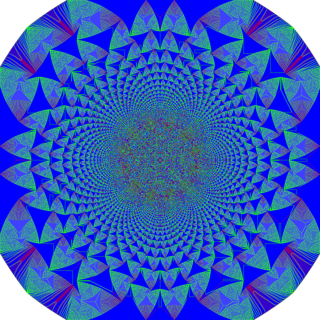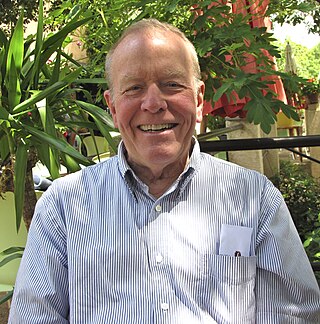Related Research Articles

Self-organized criticality (SOC) is a property of dynamical systems that have a critical point as an attractor. Their macroscopic behavior thus displays the spatial or temporal scale-invariance characteristic of the critical point of a phase transition, but without the need to tune control parameters to a precise value, because the system, effectively, tunes itself as it evolves towards criticality.
Microwave spectroscopy is the spectroscopy method that employs microwaves, i.e. electromagnetic radiation at GHz frequencies, for the study of matter.
In physics, thermalisation is the process of physical bodies reaching thermal equilibrium through mutual interaction. In general the natural tendency of a system is towards a state of equipartition of energy and uniform temperature that maximizes the system's entropy. Thermalisation, thermal equilibrium, and temperature are therefore important fundamental concepts within statistical physics, statistical mechanics, and thermodynamics; all of which are a basis for many other specific fields of scientific understanding and engineering application.

Bifurcation theory is the mathematical study of changes in the qualitative or topological structure of a given family of curves, such as the integral curves of a family of vector fields, and the solutions of a family of differential equations. Most commonly applied to the mathematical study of dynamical systems, a bifurcation occurs when a small smooth change made to the parameter values of a system causes a sudden 'qualitative' or topological change in its behavior. Bifurcations occur in both continuous systems and discrete systems.

David Pierre Ruelle is a Belgian mathematical physicist, naturalized French. He has worked on statistical physics and dynamical systems. With Floris Takens, Ruelle coined the term strange attractor, and developed a new theory of turbulence.
Otto Laporte was a German-born American physicist who made contributions to quantum mechanics, electromagnetic wave propagation theory, spectroscopy, and fluid dynamics. His name is lent to the Laporte rule in spectroscopy and to the Otto Laporte Award of the American Physical Society.

Christopher T. Hill is an American theoretical physicist at the Fermi National Accelerator Laboratory who did undergraduate work in physics at M.I.T., and graduate work at Caltech. Hill's Ph.D. thesis, "Higgs Scalars and the Nonleptonic Weak Interactions" (1977) contains one of the first detailed discussions of the two-Higgs-doublet model and its impact upon weak interactions.

In condensed-matter physics, a collision cascade is a set of nearby adjacent energetic collisions of atoms induced by an energetic particle in a solid or liquid.
The Nosé–Hoover thermostat is a deterministic algorithm for constant-temperature molecular dynamics simulations. It was originally developed by Nosé and was improved further by Hoover. Although the heat bath of Nosé–Hoover thermostat consists of only one imaginary particle, simulation systems achieve realistic constant-temperature condition. Therefore, the Nosé–Hoover thermostat has been commonly used as one of the most accurate and efficient methods for constant-temperature molecular dynamics simulations.

In condensed matter physics, a time crystal is a quantum system of particles whose lowest-energy state is one in which the particles are in repetitive motion. The system cannot lose energy to the environment and come to rest because it is already in its quantum ground state. Because of this, the motion of the particles does not really represent kinetic energy like other motion; it has "motion without energy". Time crystals were first proposed theoretically by Frank Wilczek in 2012 as a time-based analogue to common crystals – whereas the atoms in crystals are arranged periodically in space, the atoms in a time crystal are arranged periodically in both space and time. Several different groups have demonstrated matter with stable periodic evolution in systems that are periodically driven. In terms of practical use, time crystals may one day be used as quantum computer memory.
The Kibble–Zurek mechanism (KZM) describes the non-equilibrium dynamics and the formation of topological defects in a system which is driven through a continuous phase transition at finite rate. It is named after Tom W. B. Kibble, who pioneered the study of domain structure formation in the early universe, and Wojciech H. Zurek, who related the number of defects it creates to the critical exponents of the transition and to its rate—to how quickly the critical point is traversed.
Shuichi Nosé was a Japanese physicist.

James Bernhard Anderson was an American chemist and physicist. From 1995 to 2014 he was Evan Pugh Professor of Chemistry and Physics at the Pennsylvania State University. He specialized in Quantum Chemistry by Monte Carlo methods, molecular dynamics of reactive collisions, kinetics and mechanisms of gas phase reactions, and rare-event theory.
Gary T. Horowitz is an American theoretical physicist who works on string theory and quantum gravity.
Stochastic thermodynamics is an emergent field of research in statistical mechanics that uses stochastic variables to better understand the non-equilibrium dynamics present in many microscopic systems such as colloidal particles, biopolymers, enzymes, and molecular motors.
Surajit Sen is a physicist who works on theoretical and computational problems in non-equilibrium statistical physics and in nonlinear dynamics of many body systems. He holds a Ph.D in physics from The University of Georgia (1990) where he studied with M. Howard Lee. He is also interested in applying physics to study problems of relevance in a societal context. He is a professor of physics at the State University of New York, Buffalo.
Bruno Leo Zulma Nachtergaele is a Belgian mathematical physicist.
David Alan Huse is an American theoretical physicist, specializing in statistical physics and condensed matter physics.
Graham Kribs is an American theoretical particle physicist at the University of Oregon. He was elected a Fellow of the American Physical Society in 2015.
Devarajan (Dave) Thirumalai, an Indian-born American physicist, is the Collie-Welch Reagents Professor in Chemistry at the University of Texas at Austin. He researches equilibrium and non-equilibrium statistical mechanics, such as the transition from liquid to amorphous state, polymer-colloid interactions, and protein and RNA folding. He isnotedfor his contributions to the theories of protein/RNA folding, protein aggregation, glasses, and biological machines. He has also researched intrinsically disordered proteins (IDPs), organization and dynamics of chromosome and cell biophysics. Prior to moving to the University of Texas at Austin, he was a distinguished university professor in the University of Maryland from 2010 to 2015.
References
- ↑ Nosé Shuichi, 17 June 1951 -> 17 August 2005, In Memorium (sic), William Graham Hoover.
- ↑ Phil Attard (2012). Non-equilibrium Thermodynamics and Statistical Mechanics: Foundations and Applications. Oxford University Press. p. 393. ISBN 019163977X.